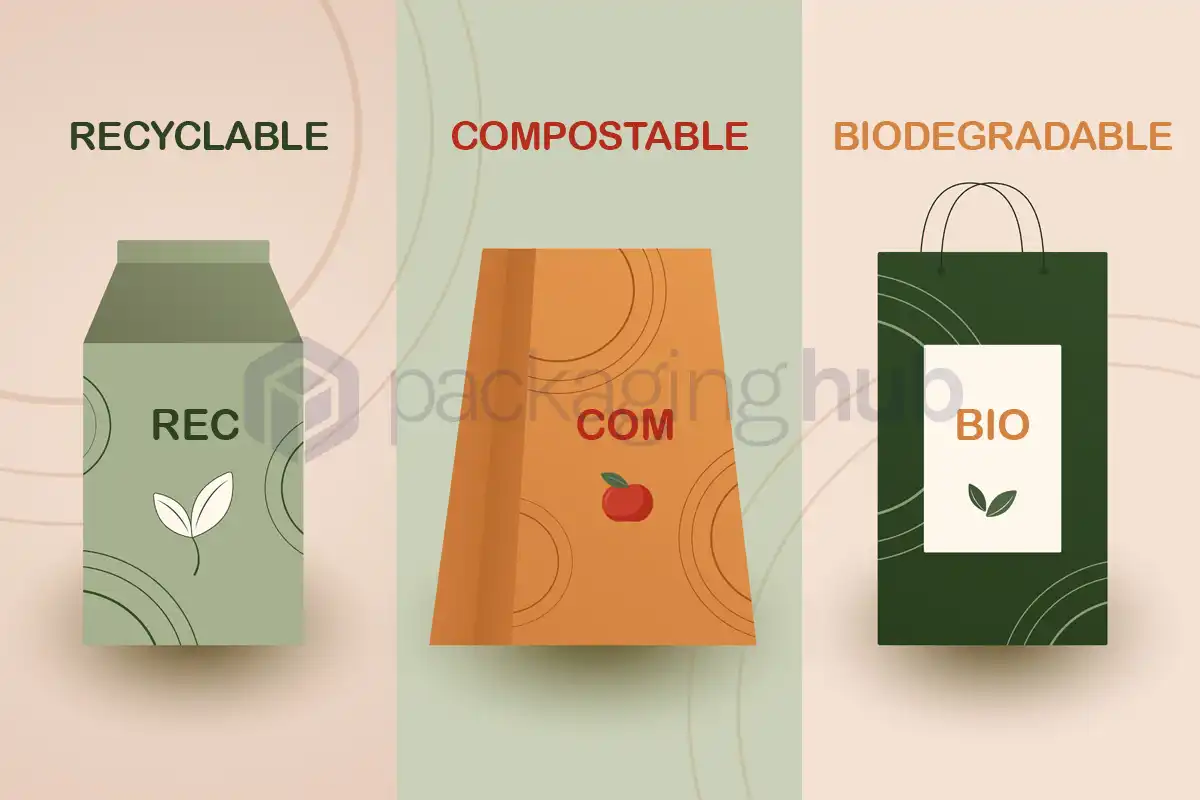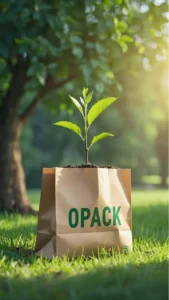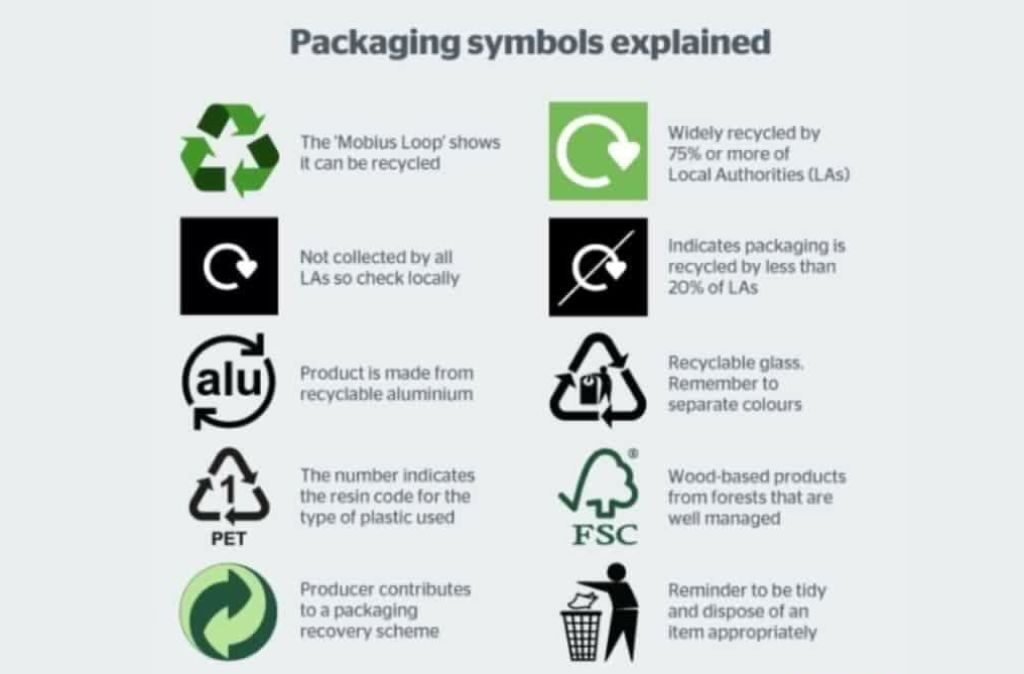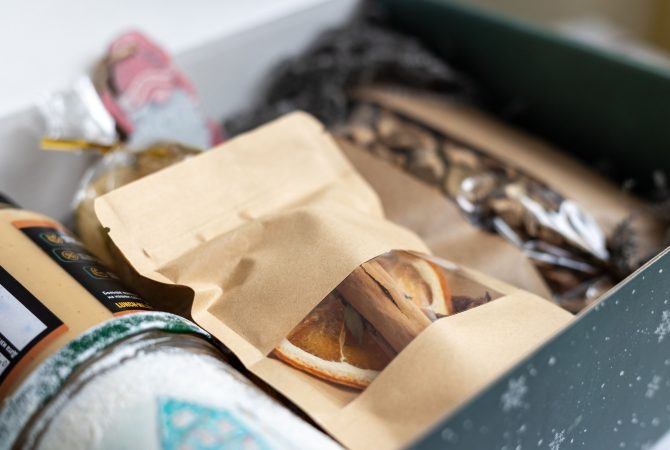I’ve watched businesses struggle with confusing eco-friendly packaging claims. They want to make responsible choices but feel overwhelmed by misleading marketing and technical jargon that obscures real environmental impact.
Compostable materials break down completely into natural elements under specific conditions, biodegradable materials decompose naturally but may leave residues, and recyclable materials can be reprocessed into new products. Each serves different applications and requires specific infrastructure to achieve environmental benefits.
When I first entered the packaging industry, sustainability was barely discussed. Today, it represents one of our most critical challenges and opportunities. Let me clarify these often-confused categories and help you make informed decisions for your business.
What Makes Compostable Packaging Different from Other Eco-Friendly Options?
I’ve seen countless businesses choose packaging labeled as "eco-friendly" without understanding what that actually means. They assume all green packaging performs the same way, leading to disappointed customers and unmet environmental goals.
Compostable packaging breaks down into natural elements (carbon dioxide, water, and biomass) under specific composting conditions, leaving no toxic residue and enriching the soil. Unlike other eco-friendly options, compostable materials completely disappear and contribute positively to soil health when properly processed.
After years of working with sustainable packaging solutions at Opack, I’ve developed deep expertise in compostable materials and their unique requirements. Let me share what makes this category special and when it works best.
Understanding True Compostability
Compostable packaging represents the most complete form of circular packaging design. When I work with clients interested in compostable solutions, I emphasize that these materials are engineered to completely disappear under controlled conditions, leaving behind only beneficial organic matter.
The composting process requires specific conditions that most people don’t realize:
- Temperature ranges of 140-160°F (60-71°C)
- Proper moisture levels (50-60%)
- Adequate oxygen flow for aerobic decomposition
- Balanced carbon-to-nitrogen ratios
- Regular turning and monitoring
These requirements mean that most compostable packaging needs industrial composting facilities rather than backyard compost bins. When I explain this to clients, they often express surprise – many assume compostable means it will break down anywhere in nature.
| Compostable Material Type | Breakdown Timeline | Required Conditions | End Products |
|---|---|---|---|
| PLA (Polylactic Acid) | 3-6 months | Industrial composting 140°F+ | CO2, water, biomass |
| Bagasse (Sugarcane fiber) | 30-90 days | Industrial or home composting | Organic matter, nutrients |
| Mushroom-based materials | 30-45 days | Home or industrial composting | Soil nutrients |
| Seaweed-based films | 4-6 weeks | Marine or industrial composting | Natural minerals |
I’ve worked with food service companies that switched to compostable packaging expecting immediate environmental benefits, only to discover their local waste management didn’t accept compostable materials. This highlights a crucial point: compostable packaging only delivers environmental benefits when proper disposal infrastructure exists.
The advantages of truly compostable packaging include complete waste elimination, soil enrichment, and reduced long-term environmental impact. However, the infrastructure limitations and higher costs compared to conventional packaging require careful consideration. In my experience, compostable packaging works best for businesses with access to commercial composting programs and customers educated about proper disposal.
How Does Biodegradable Packaging Compare to Compostable Materials?
I’ve witnessed significant confusion between biodegradable and compostable packaging among business owners. They often use these terms interchangeably, not realizing the important differences that affect both environmental impact and business decisions.
Biodegradable packaging degrades naturally over time through microbial activity but may leave residues depending on the material and environment. Unlike compostable materials, biodegradable packaging doesn’t guarantee complete breakdown or soil enrichment and can vary dramatically in decomposition rates and end products.
Through my work with various sustainable packaging materials, I’ve learned that biodegradable doesn’t automatically mean environmentally safe. The devil is truly in the details with these materials.
The Complex Reality of Biodegradable Materials
When clients ask about biodegradable packaging, I always start by explaining that this category encompasses an enormous range of materials with vastly different properties and environmental impacts. The term "biodegradable" simply means that microorganisms can break down the material – but this says nothing about how long it takes, what conditions are required, or what remains afterward.
I’ve seen biodegradable packaging that breaks down completely in weeks under ideal conditions, and others that require years in landfills while potentially releasing harmful substances. This variability makes material selection crucial for businesses serious about environmental responsibility.
The key factors that influence biodegradable packaging performance include:
- Material composition and additives
- Environmental conditions (temperature, moisture, oxygen)
- Presence of appropriate microorganisms
- Thickness and density of the packaging
- Contamination levels and other materials present
| Biodegradable Material | Typical Breakdown Time | Environmental Requirements | Potential Residues |
|---|---|---|---|
| Paper-based packaging | 2-6 weeks | Moist conditions, bacteria | Minimal if unbleached |
| Corn starch films | 6 months-2 years | Warm, moist soil conditions | Generally minimal |
| Oxo-degradable plastics | 2-5 years | UV exposure, then microbial | Microplastics possible |
| Hemp-based materials | 3-4 months | Standard composting conditions | Organic matter only |
One of the most problematic categories I encounter is oxo-degradable plastics, which some manufacturers market as biodegradable. These materials fragment into smaller pieces when exposed to heat and UV light, but may not fully biodegrade, potentially creating microplastic pollution. I always advise clients to avoid these materials despite their lower costs.
The advantage of truly biodegradable packaging lies in its ability to break down in various environments without requiring specialized facilities. However, the lack of standardization and potential for misleading claims requires careful vetting of suppliers and materials. I recommend working only with suppliers who provide third-party certifications and clear documentation of breakdown products and timelines.
For businesses considering biodegradable packaging, I suggest focusing on applications where composting infrastructure is limited but environmental responsibility remains important. Food packaging for events, agricultural applications, and situations where packaging might end up in diverse disposal environments can benefit from well-chosen biodegradable materials.
What Are the Real Advantages and Limitations of Recyclable Packaging?
I’ve observed businesses gravitate toward recyclable packaging assuming it’s the most environmentally responsible choice. They don’t realize that recyclability depends heavily on local infrastructure and consumer behavior, factors beyond their control that can undermine environmental benefits.
Recyclable packaging can be processed and reused in manufacturing new products, reducing demand for virgin materials and environmental impact. However, recycling effectiveness depends on established infrastructure, consumer participation, and material purity, making actual environmental benefits highly variable by location and application.
My experience in the packaging industry has taught me that recyclable packaging offers both the greatest potential and the most significant challenges among sustainable options. Success requires understanding the entire recycling ecosystem, not just material properties.
The Recycling Reality Check
When I discuss recyclable packaging with clients, I always emphasize that recyclability is a potential, not a guarantee. The actual environmental benefit depends on a complex chain of factors, many beyond the control of the packaging producer or brand owner.
Effective recycling requires several conditions to align:
- Consumer awareness and participation in sorting
- Collection systems that maintain material purity
- Processing facilities with appropriate technology
- Markets for recycled materials
- Economic viability throughout the chain
I’ve worked with companies that designed beautiful, technically recyclable packaging only to discover that their local recycling programs couldn’t process it or that contamination rates made recycling uneconomical. This experience taught me to always research local recycling capabilities before recommending recyclable solutions.
| Recyclable Material | Recycling Rate (US Average) | Infrastructure Requirements | Market Demand |
|---|---|---|---|
| Corrugated cardboard | 85-90% | Widespread collection, pulping | Strong, stable |
| Aluminum cans/foil | 65-70% | Specialized processing | Very high |
| PET plastic bottles | 20-30% | Chemical recycling facilities | Moderate |
| Glass containers | 25-35% | Color sorting, crushing | Limited but stable |
| Mixed paper/paperboard | 65-75% | De-inking, pulping | Variable by grade |
The advantages of recyclable packaging include proven environmental benefits when systems work properly, established consumer understanding, and mature infrastructure in many areas. Recyclable materials can also offer cost advantages since recycled content often costs less than virgin materials.
However, the limitations are significant. Recycling rates remain disappointingly low for many materials, contamination reduces effectiveness, and economic factors can make recycling unprofitable during market downturns. I’ve seen recycling programs suspend operations during economic stress, sending previously recyclable materials to landfills.
For businesses choosing recyclable packaging, I recommend focusing on materials with robust local recycling programs and high recycling rates. Corrugated cardboard and aluminum consistently perform well, while many plastic films and complex multi-material packages face significant challenges.
Clear labeling becomes crucial for recyclable packaging success. I work with clients to develop educational materials that help consumers understand proper disposal methods, contamination avoidance, and local program requirements. This investment in consumer education significantly improves actual recycling outcomes.
Which Sustainable Packaging Type Works Best for Different Applications?
I’ve seen businesses make costly mistakes by choosing sustainable packaging based on general environmental appeal rather than specific application requirements. They end up with materials that don’t perform properly or fail to achieve intended environmental benefits.
Compostable materials excel for food packaging and single-use items where contamination prevents recycling, biodegradable packaging suits applications without composting infrastructure, and recyclable packaging works best for durable goods with established collection systems. Matching material properties to specific use cases maximizes both performance and environmental benefits.
Through years of helping clients select appropriate sustainable packaging, I’ve developed clear guidelines for matching materials to applications. Let me share these insights to help you make the right choice for your specific needs.
Strategic Application Matching
When clients approach me about sustainable packaging, I start by analyzing their specific requirements rather than jumping into material options. This approach prevents mismatched solutions that satisfy neither performance nor environmental goals.
The decision framework I use considers several key factors:
- Product characteristics and protection requirements
- Distribution channels and handling conditions
- End-use environment and disposal options
- Customer base and sustainability priorities
- Budget constraints and volume requirements
For food service applications, I typically recommend compostable materials because food contamination makes recycling impractical. A restaurant chain I worked with switched from recyclable plastic containers to compostable alternatives and saw improved customer satisfaction despite higher material costs. The key was ensuring their waste hauler accepted compostable materials.
| Application Category | Recommended Material | Primary Reason | Secondary Benefits |
|---|---|---|---|
| Fresh food packaging | Compostable | Food contamination prevents recycling | Complete waste elimination |
| E-commerce shipping | Recyclable cardboard | Established collection systems | Cost-effective, protective |
| Agricultural products | Biodegradable | Often disposed in soil environments | Reduces plastic accumulation |
| Luxury retail | Recyclable with design focus | Premium appearance, reusability | Brand alignment with quality |
| Single-use foodservice | Compostable | High contamination, short lifecycle | Supports zero-waste initiatives |
I’ve found that businesses serving environmentally conscious consumers often benefit from compostable packaging even when costs are higher. The marketing value and customer loyalty generated can justify premium pricing. However, this only works when customers understand proper disposal methods and have access to appropriate facilities.
For industrial and B2B applications, recyclable packaging typically offers the best combination of performance and environmental benefit. These applications often have less contamination, more controlled disposal systems, and cost sensitivity that favors established materials.
One interesting trend I’ve observed is the hybrid approach, where businesses use different sustainable materials for different product lines or customer segments. A cosmetics company I work with uses recyclable packaging for their mainstream products and compostable materials for their premium natural line, allowing them to serve different market segments appropriately.
Consumer education becomes critical regardless of material choice. I always recommend developing clear disposal instructions and partnering with local waste management to ensure customers can properly dispose of packaging. The most environmentally friendly material becomes worthless if disposed of incorrectly.
How Should Businesses Navigate Sustainability Claims and Certifications?
I’ve watched businesses get burned by misleading sustainability claims from suppliers. They make purchasing decisions based on vague environmental promises, then discover their packaging doesn’t perform as expected or lacks credible environmental benefits.
Businesses should look for third-party certifications like BPI (compostable), ASTM standards (biodegradable), and recycling symbols with clear resin codes (recyclable). Avoid vague terms like "eco-friendly" or "green" without specific standards, and always verify claims with documentation and testing results from accredited laboratories.
After years of working with sustainable packaging suppliers and seeing the evolution of environmental claims, I’ve developed expertise in distinguishing legitimate sustainability from marketing greenwashing. Let me share how to navigate this complex landscape.
Identifying Credible Sustainability Claims
The sustainable packaging market has attracted both genuine innovators and opportunistic marketers. When I evaluate suppliers for clients, I focus on specific certifications and verifiable performance data rather than general environmental claims.
For compostable packaging, I look for certifications from organizations like:
- BPI (Biodegradable Products Institute) – North American standard
- TUV AUSTRIA OK compost – European certification
- ASTM D6400 or D6868 compliance for specific applications
- EN 13432 certification for European markets
These certifications require extensive testing and ongoing monitoring, providing reliable assurance that materials will actually compost as claimed. I’ve seen too many "compostable" materials that lack proper certification and fail to break down in real-world conditions.
| Certification Type | Issuing Organization | What It Guarantees | Red Flags to Avoid |
|---|---|---|---|
| BPI Certification | Biodegradable Products Institute | Industrial composting breakdown | "Biodegradable" without timeline |
| ASTM D6400/D6868 | American Society for Testing Materials | Specific compostability standards | "Eco-friendly" without specifics |
| Cradle to Cradle | Cradle to Cradle Products Innovation Institute | Material health and recyclability | "Green" without certification |
| FSC Certification | Forest Stewardship Council | Responsible forest management | "Sustainable" without verification |
For recyclable packaging, I verify that materials are actually accepted by local recycling programs and that recycled content claims are documented with chain-of-custody certification. The recycling symbol alone isn’t sufficient – I need to see evidence that collection and processing infrastructure exists.
Biodegradable claims require the most scrutiny because this category has the least standardization. I always request specific breakdown timelines, environmental conditions required, and end-product analysis. Materials claiming to be biodegradable "in marine environments" or "in soil" without timeframes or testing data should be avoided.
When working with suppliers, I ask for:
- Complete certification documents, not just claims
- Third-party testing results from accredited laboratories
- Specific performance data for intended applications
- Documentation of manufacturing processes and quality control
- Evidence of ongoing compliance monitoring
I’ve developed relationships with suppliers who provide transparent documentation and stand behind their environmental claims with data. These partnerships allow me to offer clients genuine sustainable options rather than materials that sound good but underperform.
For businesses evaluating sustainable packaging options, I recommend working with experienced suppliers who can provide education and documentation rather than just making sales pitches. The investment in understanding true environmental performance pays dividends in customer satisfaction and genuine environmental impact.
Conclusion
I’ve learned that choosing sustainable packaging requires understanding specific material properties, application requirements, and local infrastructure rather than relying on general environmental claims. Match compostable, biodegradable, or recyclable materials to your specific needs while ensuring proper certification and disposal systems exist for maximum environmental benefit.
Looking for a reliable and affordable supplier? OPACK is your trusted partner for creating stunning designs that leave a lasting impression and add elegance and sophistication to your packaging. Contact us now to order.










